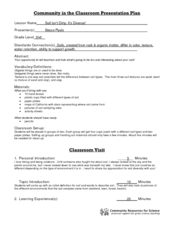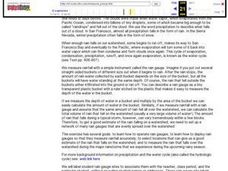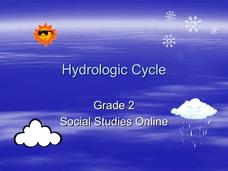Curated OER
Oceanography: Density: Designing a Hydrometer Lab
Middle schoolers explore water density and design a hydrometer to measure density. This activity is part of Ocean World's home site and excellent resources and links are provided.
Curated OER
Where's the Drip?
Students detect water leaks. In this water conservation ecology lesson, students take a tour of the school grounds and identify sources of water and possible leaks. Students report leaks to the custodian and administration.
Curated OER
Water Plants
Students examine the plants and animals that make their home in wetlands. While observing, they make sketches of the ones they see with a pencil. To end the lesson, they use watercolors to paint their flowers and animals at the local...
Curated OER
Acid Rain Viewfinder
Students are asked what does rain do? They are told that rain waters the Earth, but also drops acid. Students are told when there is too much pollution in the atmosphere that the environment can't neutralize it, the acid leaches into...
Curated OER
Above & Below the Pond
Students search for information and pictures about life in and around a pond. They visit a local ponds to sketch life that they see in the water and nearby. Students identify all plant and animal life. They find out what happens to pond...
Curated OER
Soil Isn't Dirty; It's Diverse!
Second graders participate in a soil activity. In this soil instructional activity students complete a worksheet describing different soil types and the organic and inorganic things found in them.
Curated OER
2005 Grade 8 Science Released Test Questions
Here is a collection of 22 multiple-choice questions on topics from the physical and life sciences. Apparently they came from an 8th grade comprehensive science exam and have been released for public use. They may serve as a sufficient...
Curated OER
Chesapeake Bay
The Chesapeake Bay is the largest estuary in the United States. Explore its origins, organisms, and contributing rivers with this PowerPoint. It opens with several slides of general information on the formation of estuaries, then it...
Curated OER
Burn, Baby Burn (Or Not)
Physics learners apply the concepts of fluid pressure input and output to firefighting. Divide your class into small groups and give them each a few cards that list nozzle type, hose length, hose size, and structure dimensions, They are...
Curated OER
Water Usage
Discuss how much water an individual might use for a shower, brushing teeth, and other activities. The website containing actual water use data for comparison is not valid, but perhaps you can find another by a quick internet search. At...
Curated OER
Condensation
Introduce middle school science learners to condensation with this presentation. It begins with a brief explanation of the process and humidity, but does not present all of the details. Three demonstrations need to be set up ahead of...
Curated OER
Water
The water cycle is explained in five steps in this PowerPoint. Individual slides also show color graphics of how we use water at play, at work, and at home. Tasks are given throughout the presentation. One of them asks learners to color...
Curated OER
Room Temperature Investigation
While the topic of this investigation is not specific to any particular discipline of science, it does serve as a practice of the scientific method. Learners set up a bowl containing boiling water, one with room temperature water, and...
Curated OER
Nutrition
With a little improvement, this slide show can support your introduction to nutrients. Bullet points list how the human body uses the macronutrients, however, the micronutrient slides are incomplete. You will need to insert definitions...
Curated OER
Water Molecules Can
On its own, this is not an exciting presentation on the properties of the water. It consists only of two slides: the title slide, which informs the viewer that water molecules have hydrogen bonds, and another slide, which lists four...
Curated OER
Words on Water
Young scholars use books to find quotes about or related to water. They use the subject or the style of the quote to inspire them to create their own famous words and paint a watercolor picture to accompany it.
Curated OER
Heating Curve Lab
Tenth graders examine the heating curve of water when head is added constantly over time. They input values into a calculator as they record water temperature every thirty seconds as it is heated on a hot plate. They complete the...
Curated OER
Water and the Fitness of the Environment
In this environment worksheet, young scholars answer 6 different questions. The questions are really an activity for each one. This requires extra space to complete them on separate worksheets.
Curated OER
Rainfall Measurement
Students are introduced to rainfall measurement and develop a network of rain gauges. Students measure rainfall, plot rainfall maps and calculate total rainfall volumes during rainstorms.
Curated OER
Mass and Density of an Irregular Solid
In this physics activity, students determine the density of irregular solids using water displacement method to complete 7 problems and short answer questions.
Curated OER
Engineers for a Sustainable World
Students experiment with making a water filtration system. In this engineering lesson, students get into groups and are challenged to use only eight items to create a water filter. When finished, students compare and contrast their results.
Curated OER
Earth Science
Students explore how water and waves erode the earth. In this erosion lesson students determine the processes of wave erosion and building.
Curated OER
Hurricane Strength: Spatial Association of Wind Speed and Water Temperature
In this hurricane worksheet, students read and analyze satellite images of hurricane Rita. They complete 4 short answer questions about it.
Curated OER
Hydrologic Cycle
This water cycle PowerPoint includes information based on the parts of the cycle and their purposes. Slides feature facts and examples of evaporation, condensation, and precipitation in text and visual formats.

























